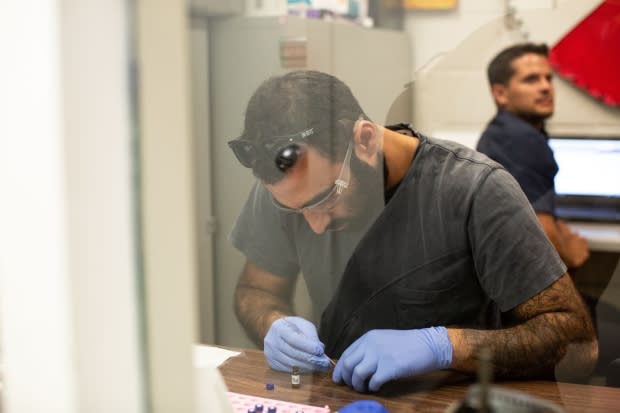New illicit drug testing machine undergoes real-world trial
A machine that can detect minuscule quantities of potentially deadly drugs was briefly put into service as part of a trial at an overdose prevention site in Vancouver's Downtown Eastside on Thursday and Friday.
The machine — which is considered by its developers to be the next generation of drug testing equipment — examined more than a hundred samples, brought to the Powell Street overdose prevention site.
The machine uses something called paper spray mass spectrometry to determine the different drugs and contaminants in a drug sample.
Other devices that use spectrometry are already in use in the neighbourhood, but Chris Gill, an analytical chemist at Vancouver Island University in Nanaimo who's developing the new equipment, said this unit is far more sensitive.
"The drug would have to be three to five per cent of a component to see it in a machine [that's currently in use]. We can detect 0.0003 per cent," said Gill.

Gill said his machine is able to identify drugs that are so potent, they only appear in tiny quantities — and can still be deadly.
"Although all drugs are dangerous, knowing that there's a toxic substance that could kill you in the drug can change behaviour," he said.
Using a smaller amount of a drug to perform the test also means users would be more likely to submit their substance to testing, as they can consume the rest, if they're comfortable with the results.
But Gill said the tiny sample required also poses a challenge. Not all street drugs are evenly manufactured, especially when they include powerful fentanyl analogues like carfentanil.
It's not uncommon to find large amounts of filler in the sample, and one can't be sure the tested sample represents the entire dose — Gill refers to this as the chocolate chip cookie effect, where the chips represent the active drugs.

"I don't think there's going to be any solution, other than dissolving the entire sample, which is not an effective way to convince someone to do a test," he said.
Nevertheless, Gill said the testing still arms the user with as much information as possible, and has the potential to bring them into contact with other health services.
In search of funding
Gill said the next steps for the technology include making it smaller and cheaper, to roughly the same cost and scale of the Fourier-Transform Infrared Spectrometer units now in use. Gill wants to see the cost per unit come down to between $60,000 and $100,000.
"We've demonstrated the technology works," he said. "I need funding to accelerate the development of smaller ... systems that can be more available in the harm reduction community, both here and around the world."
Gill said he's applying for money from the National Research Council of Canada and Health Canada adding provincial health officials could be helpful, along with any members of the public who want to contribute.
"A million dollars would go a long way," he said.
With files from Noémie Moukanda
Do you have more to add to this story? Email rafferty.baker@cbc.ca
Follow Rafferty Baker on Twitter: @raffertybaker


